Drinking Water Protection
- Drinking Water Protection Home
- About Us
- A-Z Index of Contaminants in Water
- Community Public Water Supply
- Drinking Water Grants and Loans
- Drinking Water Institute
- Drinking Water in Schools and Child Cares
- Drinking Water Revolving Fund
- Laws and Rules
- Noncommunity Public Water Supply
- Source Water Protection
- Water Operator and Certification Training
- Drinking Water Protection Contacts
Related Topics
- Annual Reports
- Drinking Water Risk Communication Toolkit
- Drinking Water Protection External Resources
- Fact Sheets
- Forms
- Invisible Heroes Videos: Minnesota's Drinking Water Providers
- Noncom Notes Newsletter
- Sample Collection Procedures (videos, pictures, written instructions)
- Waterline Newsletter
Related Sites
- 10 States Standards
- Clean Water Fund
- Health Risk Assessment – Guidance Values and Standards for Water
- Minnesota Well Index
- Water and Health
- Wells and Borings
Environmental Health Division
A Bridge to Somewhere:
Highway 53 Rerouting Includes Impact on Virginia Water Supply
From the Fall 2017 Waterline
Quarterly Newsletter of the Minnesota Department of Health Public Water Supply Unit, Waterline
A complete list of feature stories can be found on the Waterline webpage.
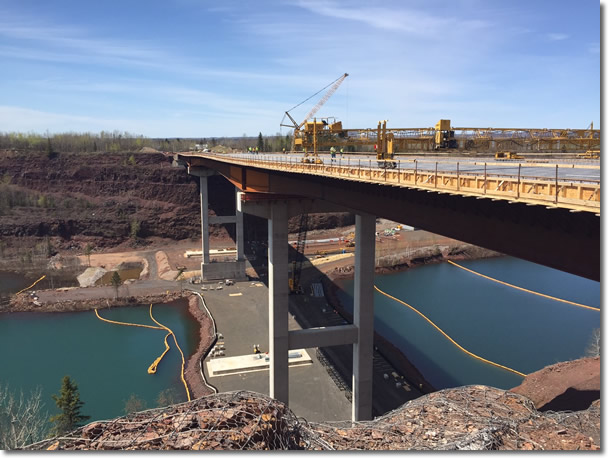
The relocation of U. S. Hwy. 53 in Virginia, necessary for mining companies to reach iron ore reserves under the existing highway, includes a bridge over the Rouchleau Pit, the source of drinking water for the city of Virginia. Minnesota Department of Health engineers are making sure the water is protected during and after construction. One of the features during construction is silt curtains (shown above). The curtains are part of a multi-layered approach to keep materials away from the drinking water intakes, which includes an impermeable liner and rock berm on the causeway below the bridge. Water and sewer lines are also being relocated with the highway and will pass under the bridge (shown below).
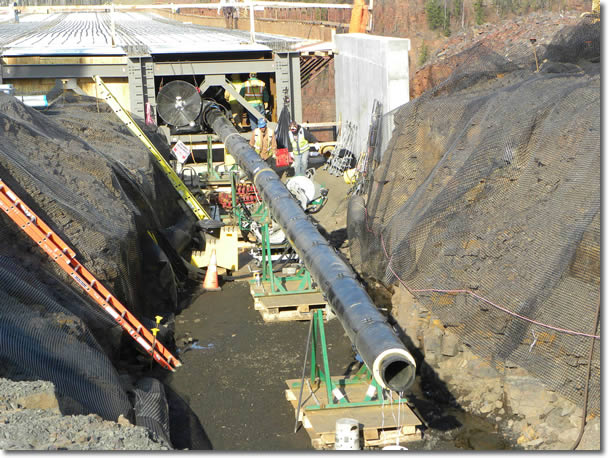
The history of the Mesabi Iron Range in northeastern Minnesota includes towns being moved so land could be mined for iron ore. Hibbing is the most notable, its residents and businesses displaced by a growing open-pit mine nearly 100 years ago.
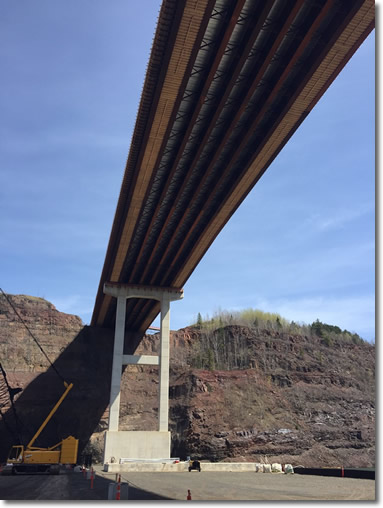 The trend continues in the 21st century with the rerouting of U. S. Hwy. 53 through Virginia, a serpentine course around the city and over the Missabe Mountain Pit (also known as the Rouchleau Pit), which is the source of drinking water for Virginia.
The trend continues in the 21st century with the rerouting of U. S. Hwy. 53 through Virginia, a serpentine course around the city and over the Missabe Mountain Pit (also known as the Rouchleau Pit), which is the source of drinking water for Virginia.
In the early 1960s the Minnesota Department of Transportation (MnDOT) secured an easement to turn Highway 53 into a four-lane road. The agreement allowed the mining company to retain ownership of the land and the power to have the state vacate the land. Through 1987 the mining company-U. S. Steel, the original owner, or its successor—was responsible for moving the road. It became the state’s responsibility after 1987.
In 2010, it happened. The land owner, RGGS Lands and Minerals of Pelham, Alabama, notified MnDOT that it wanted to expand its Thunderbird Mine to access the iron ore that is beneath a section of Hwy. 53, on the south and west side of the Rouchleau Pit. MnDOT, RGGS, and Cliffs Natural Resources of Cleveland (the lessee of the land) negotiated a schedule that called for the highway, along with all utilities of the city of Virginia and the Virginia Public Utilities Commission to be removed by 2017 as well as infrastructure and the Mesabi Trail.
The result was a massive project in terms of coordination and planning that involved other state and federal agencies, including the Minnesota Department of Health (MDH), to perform plan review and source water protection measures related to the city’s water supply.
 |
| The placement of concrete on the bridge deck over the Rouchleau Pit began May 9, 2017. |
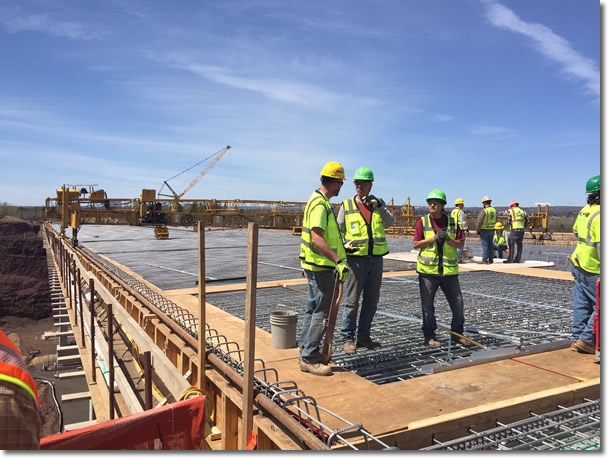 |
The project used the process of Construction Management General Contractor (CMGC) as opposed to a low-bid or design-build method. CMGC, which is relatively new to the transportation industry, incorporates the owner, designer, and contractor and allows the owner to hire a contractor to collaborate with the owner and designer to explore efficient construction means and methods, reduce risk, define and reduce the construction schedule, and increase cost certainty during the design phase and before the start of construction.
Pat Huston, the project engineer for MnDOT, said, “With CMGC we were able to plan the resources needed to complete this on schedule.” Construction began on November 2, 2015, fewer than nine months after the design contract was executed. The prime contractor on the project is Kiewit Infrastructure Company of Omaha, and 29 subcontractors (28 from Minnesota) are completing approximately 30 percent of the work.
MnDOT had explored options for moving the highway before settling for a 3.1 mile route to the east of the Rouchleau Pit that reconnects with the existing Hwy. 53 after crossing the 1,125-foot-long bridge over the pit. The Mesabi Trail, a pedestrian and bicycling trail, which is also open to snowmobiles in the winter, is part of the bridge and separated by a railing from the traffic lanes. Pedestrian plazas are at each end of the bridge with a time capsule on the eastern side.
Kiewit had first considered using barges to bring in materials and staging its operations but instead opted for an earthen causeway beneath the bridge. The causeway was created with more than 300,000 cubic yards of fill, waste rock owned by the Minnesota Department of Natural Resources taken from near the project. The causeway, which is permeable enough to allow water in the pit to pass through, remains in place for maintenance uses.
With the eastern pier of the bridge rising more than 200 feet above the pit, the bridge is one of the tallest—if not the tallest—in the MnDOT system. Pilings for both piers were drilled into bedrock. Shoring towers, which had been used for the new Minnesota Vikings stadium in downtown Minneapolis and made adaptable enough for use on other projects, were brought in to temporarily support the large steel bridge girders until they were all in place and spliced together.
The placement of 80 girders, totaling 10 million pounds, began in the fall of 2016 and was completed in January 2017. A gigantic Terex CC6800 1375 Ton Crawler, the same model as was used for the Vikings stadium, was brought in to lift the girders from the causeway to the bridge deck. Huston said the girders were spliced into “four packs,” two pieces end-to-end coupled with another parallel pair. Weather was a factor with the schedule; the girders could not be lifted if the wind was more than 12 miles per hour.
“The Terex crane minimized the number of picks the contractor had to make, thus reducing the risk and increasing safety,” Huston said, adding that the heaviest of the lifts was 750,000 pounds.
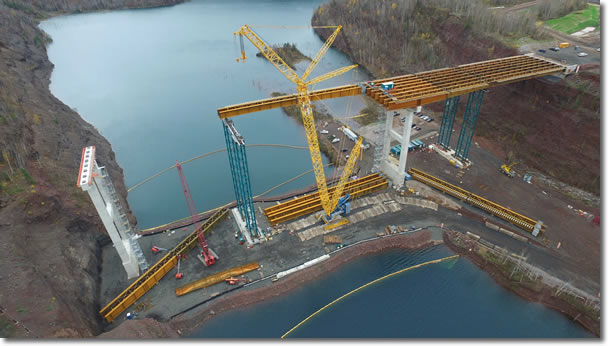 |
| An aerial view from the north of the mammoth Terex crane lifting girders into place. |
The girders were fabricated at Veritas Steel in Eau Claire, Wisconsin, more than 200 miles from the project. A special route needed to be worked out to get the girders to the site and had to be coordinated with paving and other road projects along the way.
In addition to the highway, watermains were also rerouted along the highway and across the bridge. MDH engineers Brian Noma, David Weum, and David Rindal oversaw the plan review portion of construction related to water supply. All have been involved since the beginning of the project, working with the contractors on concerns related to the Safe Drinking Water Act and the impacts of construction.
MDH hydrologist Tracy Lund worked on issues related to source water protection and noted that stormwater runoff goes to retention ponds on the east side of the bridge rather than directly into the water below, slowing the infiltration process. The bridge has no deck drains; in addition, snow will be plowed to the side of the bridge and then removed by MnDOT, using snow blowers and trucks.
The bridge is opening to traffic in August 2017 with the infrastructure removed along the old portion of the highway so that mining operations could begin as soon as possible. Even the final work, including landscaping, is being completed in 2017 instead of the following spring, as was originally planned.
Huston said the early completion will save money by not having overhead through another winter, helping with the price tag of $240 million for the total project. The cost includes the purchase of the mineral deposits below the highway so that MnDOT has full ownership of the highway and the land.
Even though he won’t be around for the life of the bridge, projected to be at least 100 years, Huston thought of those who will follow and said, “We don’t want to have to go through this again.”
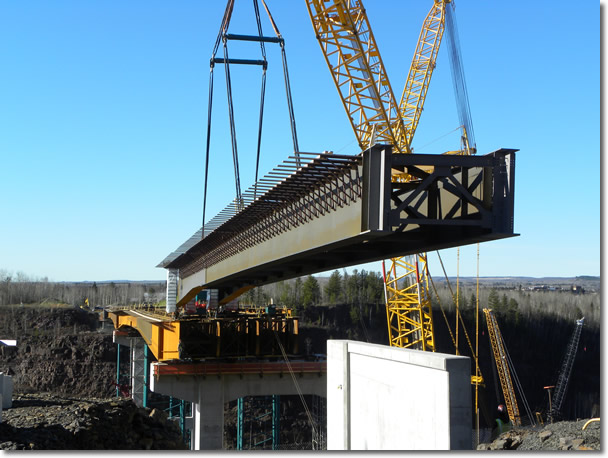 |
| Placement of the girders, using the Terex crane, began in the fall of 2016 and continued into the winter. |
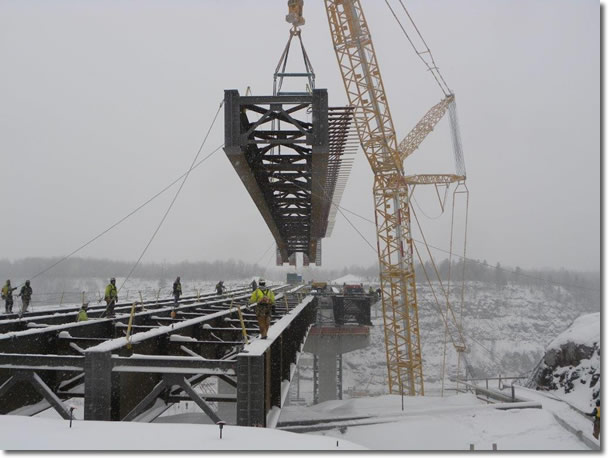 |
Go to top